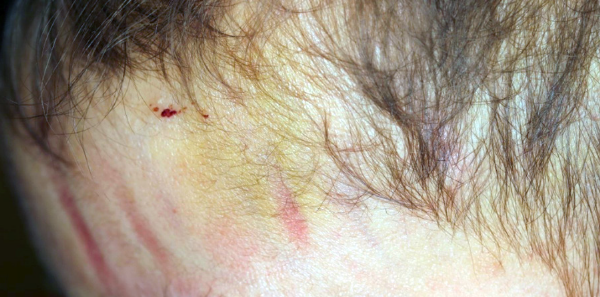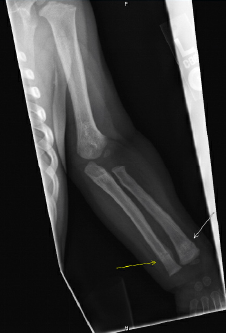
The Case
A 2-year-old male presents with vomiting. He was seen by his pediatrician two days ago after having fallen from his mother’s lap. At that time, the pediatrician noted bruising to the child’s face (see Figure 1). A radiograph of his facial bones was normal. The child has been fussy since then and today vomited several times.
Explore This Issue
ACEP Now: Vol 40 – No 05 – May 2021Diagnosis Tips
Abusive head trauma (AHT) can be caused by shaking of a child or direct impact to the head of a child. AHT is fatal more often than any other form of child abuse injury.1,2 AHT sustained in the first year of life is fatal in nearly a quarter of cases.2 Children who survive AHT are often left with significant long-term morbidity, including intellectual disability, seizure disorders, cortical blindness, endocrine dysfunction, and neuromuscular disorders.3
AHT may be a challenging diagnosis to make because patients often present with nonspecific symptoms. However, it is crucial for emergency clinicians to consider AHT because up to 28 percent of AHT victims suffer subsequent injuries if the initial diagnosis is missed.2
As many as 30 percent of AHT cases are misdiagnosed at initial presentation. Factors contributing to misdiagnosis include presentation with nonspecific symptoms, race (white children are more often misdiagnosed), and the presence of both biological parents in the household. The lack of radiologists specializing in pediatrics may allow for incorrect interpretations of radiological studies, further contributing to missed AHT.2
Most AHT is not planned; perpetrators often inflict AHT during attempts to make an infant stop crying. Thus, many patients with AHT present with an altered level of consciousness. Other common presentations of AHT include bruising to the torso, ears, or neck in a child under age 4 (ie, TEN-4 bruising), bruising to any child younger than 4 months, vomiting without diarrhea, poor feeding, and irritability.2,4 In contrast, the most common presentation of unintentional head trauma is localized scalp swelling in an otherwise asymptomatic child.5

Figure 2 (LEFT): Radiograph of an arm fracture from a pediatric skeletal survey.
Heather Rozzi
A thorough review of the patient’s chart, including previous emergency department visits and outpatient visits, may improve the odds of diagnosing AHT. In one chart review, more than a quarter of children who suffered severe physical abuse had previous abusive trauma that was missed or misdiagnosed by physicians. The most common misses were related to encounters with a chief complaint of bruising in which the history provided was unlikely to be accurate due to the developmental stage of the child or in which the mechanism could not plausibly have caused the injury.6 Pierce and colleagues described bruising in the TEN-4 distribution as a common sentinel injury for later, more significant physical abuse.4
Once AHT is considered as a diagnosis, a thorough evaluation is warranted; laboratory and radiological studies are often required. Traumatic head injury in conjunction with other traumatic injuries such as fractures, retinal hemorrhage, intra-abdominal injury, or oropharyngeal injury is significantly more concerning for AHT than an isolated head injury alone.7
Neuroimaging (such as CT and/or MRI) should be obtained to provide a diagnosis and to ascertain the extent and (to some degree) the timing of the injuries.7 A skeletal survey (see Figure 2) should also be obtained and, ideally, interpreted by a pediatric radiologist; 42 percent of children with AHT have occult fractures.
Lab abnormalities may include anemia due to intracranial or intra-abdominal injuries. Electrolytes, liver function tests, pancreatic enzymes, and a urinalysis are also recommended to identify potential injuries to other organ systems.7
A multidisciplinary approach is recommended for children with AHT. Involvement of child protective services is legally required. Where available, consultation with pediatric trauma surgery, pediatric ophthalmology, and pediatric neurology/neurosurgery should be obtained. If available, child abuse specialists can provide significant assistance with evaluation and disposition.
Case Resolution
Due to the patient’s head injury and vomiting, CT of the head was obtained and showed a 4 mm left frontal subdural hematoma that appeared acute. A skeletal survey revealed healing rib fractures. The child was hospitalized, and child protective services was notified.
Dr. Rozzi is an emergency physician; director of the Forensic Examiner Team at WellSpan York Hospital in York, Pennsylvania; and chair of the Forensic Section of ACEP.
Dr. Riviello is chair and professor of emergency medicine at the University of Texas Health Science Center at San Antonio.
References
- Hung KL. Pediatric abusive head trauma. Biomed J. 2020;43(3):240-250.
- Jenny C, Hymel KP, Ritzen A, et al. Analysis of missed cases of abusive head trauma. JAMA. 1999;281(7):621-626.
- Barlow KM, Thomson E, Johnson D, et al. Late neurologic and cognitive sequelae of inflicted traumatic brain injury in infancy. Pediatrics. 2005;116(2):e174-185.
- Pierce MC, Kaczor K, Aldridge S, et al. Bruising characteristics discriminating physical child abuse from accidental trauma. Pediatrics. 2010;125(1):67-74.
- Keenan HT, Runyan DK, Marshall SW, et al. A population-based study of inflicted traumatic brain injury in young children. JAMA. 2003;290(5):621-626.
- Sheets LK, Leach ME, Koszewski IJ, et al. Sentinel injuries in infants evaluated for child physical abuse. Pediatrics. 2013;131(4):701-707.
- Christian C. Evaluation and diagnosis of abusive head trauma in infants and children. UpToDate website. Accessed March 8, 2021.





No Responses to “Tips for Diagnosing Abusive Head Trauma”